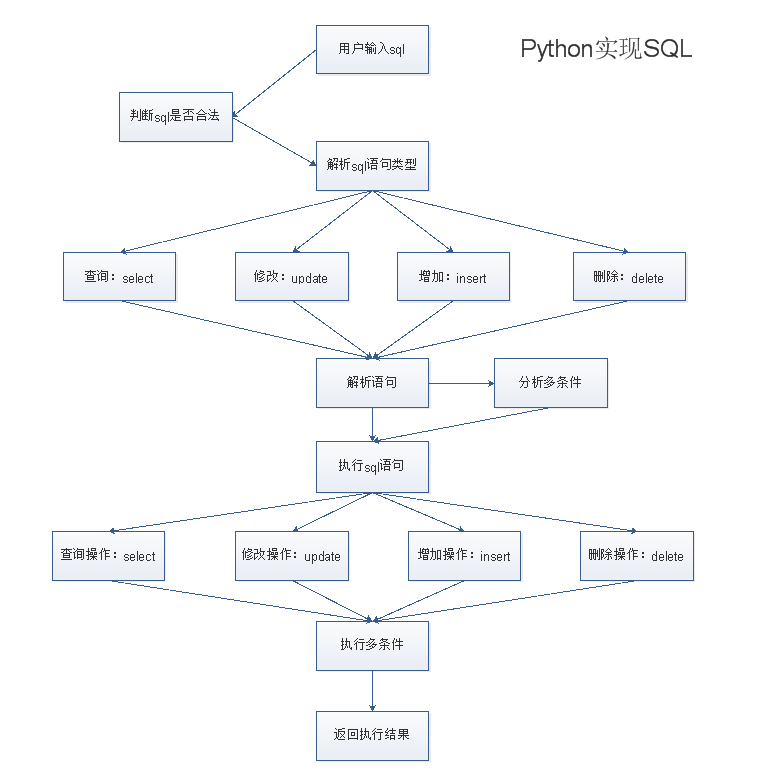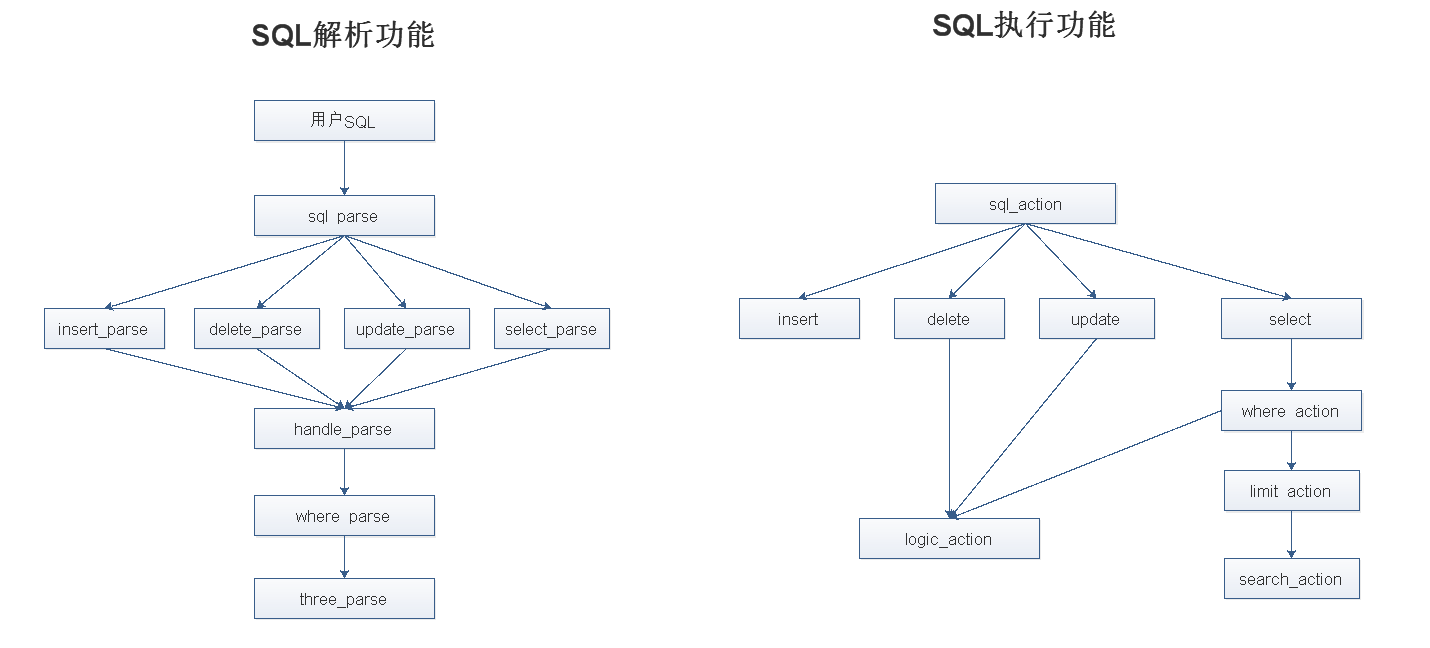Python操作文件模拟SQL语句功能
一、需求
当然此表你在文件存储时可以这样表示
1,Alex Li,22,13651054608,IT,2013-04-01 现需要对这个员工信息文件,实现增删改查操作
1. 可进行模糊查询,语法至少支持下面3种:
1. select name,age from staff_table where age > 22
2. select * from staff_table where dept = "IT"
3. select * from staff_table where enroll_date like "2013"
4. 查到的信息,打印后,最后面还要显示查到的条数
2. 可创建新员工纪录,以phone做唯一键,staff_id需自增
3. 可删除指定员工信息纪录,输入员工id,即可删除
4. 可修改员工信息,语法如下:
1. UPDATE staff_table SET dept="Market" WHERE where dept = "IT"
注意:以上需求,要充分使用函数,请尽你的最大限度来减少重复代码!
二、实现流程
第一部分:SQL解析
- 1.接收用户SQL
- 判断用户输入是否为SQL
- 2.SQL解析主函数sql_parse
- 分发SQL给对应语句的函数来做解析
- insert_parse
- delete_parse
- update_parse
- select_parse
- 解析后交给handle_parse,来控制返回
- 解析SQL语句中的多条件
- where_parse
- three_parse
- 返回解析后的SQL
- 分发SQL给对应语句的函数来做解析
第二部分:SQL执行
-
1.接收解析后的SQL
-
2.SQL执行主函数sql_action
- 分发SQL给对应函数来执行
- insert
- delete
- update
- select
- 执行SQL语句时的多条件
- where_action
- logic_action
- limit_action
- search_action
- 返回执行SQL的结果
- 分发SQL给对应函数来执行
三、图解


四、代码

1 #/usr/local/env python 2 #_*_coding:utf-8_*_ 3 4 #第一部分:sql解析 5 import os 6 def sql_parse(sql): #用户输入sql 转成结构化的字典 7 ''' 8 第一步:sql解析 流程 9 1.收到 sql查询条件 10 2.sql_parse 来分发要求给 select_parse 11 3.select_parse 调用 handle_parse 解析sql 12 4.handle_parse 返回解析sql后的结果 sql_dic 给 select_parse 13 5.select_parse 把 sql_dic 返回给sql_parse 14 sql_dic=sql_parse(sql) #用户输入sql 转成结构化的字典sql_dic 15 sql语句四种操作格式:insert delete update select 16 提取用户输入sql 的操作关键词 再进行分析和分发操作 17 把sql字符串切分,提取命令信息,分发给具体解析函数去解析 18 :param sql:用户输入的字符串 19 :return:返回字典格式sql解析结果 20 ''' 21 #sql命令操作 解析函数的字典 根据用户的命令来找相对应的函数 22 parse_func={ 23 'insert':insert_parse, 24 'delete':delete_parse, 25 'update':update_parse, 26 'select':select_parse, 27 } 28 29 #print('用户输入 sql str is : %s' %sql) #打印用户输入的sql 30 sql_l=sql.split(' ') #按空格切割用户sql 成列表 方便提取命令信息 31 func=sql_l[0] #取出用户的sql命令 32 33 #判断用户输入的sql命令 是否在定义好的sql命令函数的字典里面,如果不在字典里面,则返回空 34 res='' 35 if func in parse_func: 36 res=parse_func[func](sql_l) #把切割后的 用户sql的列表 传入对应的sql命令函数里 37 38 return res 39 40 def insert_parse(sql_l): 41 ''' 42 定义insert语句的语法结构,执行sql解析操作,返回sql_dic 43 :param sql:sql按照空格分割的列表 44 :return:返回字典格式的sql解析结果 45 ''' 46 sql_dic={ 47 'func':insert, #函数名 48 'insert':[], #insert选项,留出扩展 49 'into':[], #表名 50 'values':[], #值 51 } 52 return handle_parse(sql_l,sql_dic) 53 54 def delete_parse(sql_l): 55 ''' 56 定义delete语句的语法结构,执行sql解析操作,返回sql_dic 57 :param sql:sql按照空格分割的列表 58 :return:返回字典格式的sql解析结果 59 ''' 60 sql_dic = { 61 'func': delete, 62 'delete': [], # delete选项,留出扩展 63 'from': [], # 表名 64 'where': [], # filter条件 65 } 66 return handle_parse(sql_l, sql_dic) 67 68 def update_parse(sql_l): 69 ''' 70 定义update语句的语法结构,执行sql解析操作,返回sql_dic 71 :param sql:sql按照空格分割的列表 72 :return:返回字典格式的sql解析结果 73 ''' 74 sql_dic = { 75 'func': update, 76 'update': [], # update选项,留出扩展 77 'set': [], # 修改的值 78 'where': [], # filter条件 79 } 80 return handle_parse(sql_l, sql_dic) 81 82 def select_parse(sql_l): 83 ''' 84 定义select语句的语法结构,执行sql解析操作,返回sql_dic 85 :param sql:sql按照空格分割的列表 86 :return:返回字典格式的sql解析结果 87 ''' 88 # print('from in the select_parse :�33[42;1m%s�33[0m' %sql_l) 89 # select语句多种条件查询,列成字典,不同条件不同列表 90 sql_dic={ 91 'func':select, #执行select语句 92 'select':[], #查询字段 93 'from':[], #数据库.表 94 'where':[], #filter条件,怎么找 95 'limit':[], #limit条件,限制 96 } 97 return handle_parse(sql_l,sql_dic) 98 99 def handle_parse(sql_l,sql_dic): #专门做sql解析操作 100 ''' 101 执行sql解析操作,返回sql_dic 102 :param sql_l: sql按照空格分割的列表 103 :param sql_dic: 待填充的字典 104 :return: 返回字典格式的sql解析结果 105 ''' 106 # print('sql_l is �33[41;1m%s�33[0m sql_dic is �33[41;1m%s�33[0m' %(sql_l,sql_dic)) 107 108 tag=False #设置警报 默认是关闭False 109 for item in sql_l: #循环 按空格切割用户sql的列表 110 if tag and item in sql_dic: #判断警报拉响是True 并且用户sql的条件 在条件select语句字典里面,则关闭警报 111 tag=False #关闭警报 112 if not tag and item in sql_dic: #判断警报没有拉响 并且用户sql的条件 在条件select语句字典里面 113 tag=True #拉响警报 114 key=item #取出用户sql的条件 115 continue #跳出本次判断 116 if tag: #判断报警拉响 117 sql_dic[key].append(item) #把取出的用户sql 添加到 select语句多种条件对应的字典里 118 if sql_dic.get('where'): #判断 用户sql where语句 119 sql_dic['where']=where_parse(sql_dic.get('where')) #['id>4','and','id<10'] #调用where_parse函数 把整理好的用户sql的where语句 覆盖之前没整理好的 120 # print('from in the handle_parse sql_dic is �33[43;1m%s�33[0m' %sql_dic) 121 return sql_dic #返回 解析好的 用户sql 字典 122 123 def where_parse(where_l): #['id>','4','and','id','<10'] ---> #['id>4','and','id<10'] 124 ''' 125 分析用户sql where的各种条件,再拼成合理的条件字符串 126 :param where_l:用户输入where后对应的过滤条件列表 127 :return: 128 ''' 129 res=[] #存放最后整理好条件的列表 130 key=['and','or','not'] #逻辑运算符 131 char='' #存放拼接时的字符串 132 for i in where_l: #循环用户sql 133 if len(i) == 0 :continue #判断 长度是0 就继续循环 134 if i in key: 135 #i为key当中存放的逻辑运算符 136 if len(char) != 0: #必须 char的长度大于0 137 char=three_parse(char) #把char字符串 转成列表的形式 138 res.append(char) #把之前char的字符串,加入res #char='id>4'--->char=['id','>','4'] 139 res.append(i) #把用户sql 的逻辑运算符 加入res 140 char='' #清空 char ,为了下次加入char到res时 数据不重复 141 else: 142 char+=i #'id>4' #除了逻辑运算符,都加入char #char='id<10'--->char=['id','>','4'] 143 else: 144 char = three_parse(char) # 把char字符串 转成列表的形式 145 res.append(char) #循环完成后 char里面有数据 ,再加入到res里面 146 # ['id>4','and','id<10'] ---> #['id','>','4','and','id','<','10'] 147 # print('from in the where_parse res is �33[43;1m%s�33[0m' % res) 148 return res #返回整理好的 where语句列表 149 150 def three_parse(exp_str): # 把where_parse函数里面 char的字符串 转成字典 151 ''' 152 将每一个小的过滤条件如,name>=1转换成['name','>=','1'] 153 :param exp_str:条件表达式的字符串形式,例如'name>=1' 154 :return: 155 ''' 156 key=['>','<','='] #区分运算符 157 res=[] #定义空列表 存放最终值 158 char='' #拼接 值的字符串 159 opt='' #拼接 运算符 160 tag=False #定义警报 161 for i in exp_str: #循环 字符串和运算符 162 if i in key: #判断 当是运算符时 163 tag=True #拉响警报 164 if len(char) != 0: #判断char的长度不等于0时(方便添加连续运算符)才做列表添加 165 res.append(char) #把拼接的字符串加入 res列表 166 char='' #清空char 使下次循环不重复添加数据到res列表 167 opt+=i #把循环的运算符加入opt 168 if not tag: #判断 警报没有拉响 169 char+=i #把循环的字符串加入 char 170 171 if tag and i not in key: #判断 警报拉响(表示上次循环到运算符),并且本次循环的不是运算符 172 tag=False #关闭警报 173 res.append(opt) #把opt里面的运算符 加入res列表 174 opt='' #清空opt 使下次循环不重复添加数据到res列表 175 char+=i #把循环到的 字符串加入char 176 else: 177 res.append(char) #循环结束,把最后char的字符串加入res列表 178 179 #新增解析 like的功能 180 if len(res) == 1: #判断 ['namelike李'] 是个整体 181 res=res[0].split('like') #以like切分字符串 182 res.insert(1,'like') #加入like字符串,因为上面切分的时候剔除了like 183 184 # print('three_parse res is �33[43;1m%s�33[0m' % res) 185 return res #返回res列表结果 186 187 #第二部分:sql执行 188 def sql_action(sql_dic): #接收用户输入的sql 的结构化的字典 然后执行sql 189 ''' 190 从字典sql_dic提取命令,分发给具体的命令执行函数去执行 191 执行sql的统一接口,内部执行细节对用户完全透明 192 :param sql_dic: 193 :return: 194 ''' 195 return sql_dic.get('func')(sql_dic) #接收用户sql,分发sql,执行命令 196 197 def insert(sql_dic): 198 print('insert %s' %sql_dic) 199 db,table=sql_dic.get('into')[0].split('.') #切分文件路径,相对应数据库,表 200 with open('%s/%s' %(db,table),'ab+') as fh: #安装上面的路径 打开文件 ab+模式 201 # 读出文件最后一行,赋值给last 配合+ 202 offs = -100 # 203 while True: 204 fh.seek(offs,2) 205 lines = fh.readlines() 206 if len(lines)>1: 207 last = lines[-1] 208 break 209 offs *= 2 210 last=last.decode(encoding='utf-8') 211 212 last_id=int(last.split(',')[0]) #取出最后一行id号 213 new_id=last_id+1 #id号加1 实现id自增效果 214 #insert into db1.emp values alex,30,18500841678,运维,2007-8-1 215 record=sql_dic.get('values')[0].split(',') #提取用户想要 添加的sql 216 record.insert(0,str(new_id)) #加入自增后的id 到用户sql的头部 217 218 #['26','alex','35','13910015353','运维','2005 - 06 - 27 '] 219 record_str=','.join(record)+' ' #把用户sql列表切成字符串 220 fh.write(bytes(record_str,encoding='utf-8')) #把添加 id后的用户想添加的sql 用bytes写入文件 221 fh.flush() 222 return [['insert successful']] 223 224 def delete(sql_dic): 225 db,table=sql_dic.get('from')[0].split('.') 226 bak_file=table+'_bak' 227 with open("%s/%s" %(db,table),'r',encoding='utf-8') as r_file, 228 open('%s/%s' %(db,bak_file),'w',encoding='utf-8') as w_file: 229 del_count=0 230 for line in r_file: 231 title="id,name,age,phone,dept,enroll_date" 232 dic=dict(zip(title.split(','),line.split(','))) 233 filter_res=logic_action(dic,sql_dic.get('where')) 234 if not filter_res: 235 w_file.write(line) 236 else: 237 del_count+=1 238 w_file.flush() 239 os.remove("%s/%s" % (db, table)) 240 os.rename("%s/%s" %(db,bak_file),"%s/%s" %(db,table)) 241 return [[del_count],['delete successful']] 242 243 def update(sql_dic): 244 #update db1.emp set id='sb' where name like alex 245 db,table=sql_dic.get('update')[0].split('.') 246 set=sql_dic.get('set')[0].split(',') 247 set_l=[] 248 for i in set: 249 set_l.append(i.split('=')) 250 bak_file=table+'_bak' 251 with open("%s/%s" %(db,table),'r',encoding='utf-8') as r_file, 252 open('%s/%s' %(db,bak_file),'w',encoding='utf-8') as w_file: 253 update_count=0 254 for line in r_file: 255 title="id,name,age,phone,dept,enroll_date" 256 dic=dict(zip(title.split(','),line.split(','))) 257 filter_res=logic_action(dic,sql_dic.get('where')) 258 if filter_res: 259 for i in set_l: 260 k=i[0] 261 v=i[-1].strip("'") 262 print('k v %s %s' %(k,v)) 263 dic[k]=v 264 print('change dic is %s ' %dic) 265 line=[] 266 for i in title.split(','): 267 line.append(dic[i]) 268 update_count+=1 269 line=','.join(line) 270 w_file.write(line) 271 272 w_file.flush() 273 os.remove("%s/%s" % (db, table)) 274 os.rename("%s/%s" %(db,bak_file),"%s/%s" %(db,table)) 275 return [[update_count],['update successful']] 276 277 def select(sql_dic): 278 ''' 279 执行select语句,接收解析好的sql字典 280 :param sql_dic: 281 :return: 282 ''' 283 # print('from select sql_dic is %s' %sql_dic) #打印 解析好的sql字典 284 285 # first:form 286 db,table=sql_dic.get('from')[0].split('.') #切分出库名和表名,就是文件路径 287 288 fh=open("%s/%s" %(db,table),'r',encoding='utf-8') #打开文件 根据取到的路径 289 290 #second:where 291 filter_res=where_action(fh,sql_dic.get('where')) #定义where执行函数,查询条件 292 fh.close() 293 # for record in filter_res: # 循环打印 用户sql where的执行结果 294 # print('file res is %s' %record) 295 296 #third:limit 297 limit_res=limit_action(filter_res,sql_dic.get('limit')) #定义limit执行函数,限制行数 298 # for record in limit_res: # 循环打印 显示用户sql limit的执行结果 299 # print('limit res is %s' %record) 300 301 #lase:select 302 search_res=search_action(limit_res,sql_dic.get('select')) #定义select执行函数 303 # for record in search_res: # 循环打印 显示用户sql select的执行结果 304 # print('select res is %s' %record) 305 306 return search_res 307 308 def where_action(fh,where_l): #执行where条件语句 where_l=where的多条件解析后的列表 309 #id,name,age,phone,dept,enroll_data 310 #10,吴东杭,21,17710890829,运维,1995-08-29 311 #['id>7', 'and', 'id<10', 'or', 'namelike'] 312 313 # print('in where_action �33[41;1m%s�33[0m' %where_l) 314 res=[] #定义最后返回值的列表 315 logic_l=['and','or','not'] #定义逻辑运算符 316 title="id,name,age,phone,dept,enroll_data" #定义好表文件内容的标题 317 if len(where_l) != 0: #判断用户sql 是否有where语句 318 for line in fh: #循环 表文件 319 dic=dict(zip(title.split(','),line.split(','))) #一条记录 让标题和文件内容一一对应 320 #逻辑判断 321 logic_res=logic_action(dic,where_l) #让 logic_action函数来操作对比 322 if logic_res: #如果逻辑判断为True 323 res.append(line.split(',')) #加入res 324 else: 325 res=fh.readlines() #用户sql 没有where语句,则返回表文件所有内容 326 327 # print('>>>>>>>> %s' %res) 328 return res #返回执行 where 后的结果 329 330 def logic_action(dic,where_l): 331 ''' 332 用户sql select的where多条件 执行对比文件内容 333 文件内容 跟所有的 where_l 的条件比较 334 :param dic: 335 :param where_l: 336 :return: 337 ''' 338 # print('from logic_action %s' %dic) #from logic_action {'id': '23', 'name': '翟超群', 'age': '24', 'phone': '13120378203', 'dept': '运维', 'enroll_data': '2013-3-1 '} 339 # print('---- %s' %where_l) #[['name', 'like', '李'], 'or', ['id', '<=', '4']] 340 res=[] #存放 bool值 结果的空列表 341 # where_l=[['name', 'like', '李'], 'or', ['id', '<=', '4']] 342 for exp in where_l: #循环where条件列表,跟dic做比较 343 #dic与exp做bool运算 344 if type(exp) is list: #只留下 where_l列表里 相关的条件 345 #如果是列表 做bool运算 #[['name', 'like', '李'] 346 exp_k,opt,exp_v=exp #匹配 一个where条件列表的格式 347 if exp[1] == '=': #如果 列表的运算符是 =号 348 opt="%s=" %exp[1] #用字符串拼接出 两个 ==号 349 if dic[exp_k].isdigit(): #判断是否数字 用户的条件是否对应文件内容(字典) 350 dic_v=int(dic[exp_k]) #文件内容的数字 转成整形 做比较 351 exp_v=int(exp_v) #where_l列表的数字 转成整形 做比较 352 else: 353 dic_v="'%s'" %dic[exp_k] #不是数字的时候 存取出来 354 if opt != 'like': #如果运算符 不是 like 355 exp=str(eval("%s%s%s" %(dic_v,opt,exp_v))) #转成字符串(逻辑判断后是bool值):做逻辑判断:文件数字,运算符,用户数字 356 else: #如果 运算符位置是 like 357 if exp_v in dic_v: #判断 sql里like的值 是否在 文件内容里 358 exp='True' 359 else: 360 exp='False' 361 res.append(exp) #['True','or','False','or','true'] 362 363 # print('---------- %s' %res) 364 res=eval(" ".join(res)) # 把bool值列表转成字符串 然后再做逻辑判断 结果是bool值 365 return res #返回 res结果 366 367 def limit_action(filter_res,limit_l): #执行limit条件 限制行数 368 res=[] #最后的返回值列表 369 if len(limit_l) != 0: #判断 用户sql 是否有 limit条件 370 index=int(limit_l[0]) #取出 用户sql limit条件的数字 371 res=filter_res[0:index] 372 else: #如果 用户sql 没有 limit条件 就整个返回 373 res=filter_res 374 return res #返回最后的sql结果 375 376 def search_action(limit_res,select_l): #执行select执行函数 377 res=[] #最后的返回值列表 378 fileds_l = [] 379 title = "id,name,age,phone,dept,enroll_data" #title = select的条件 380 if select_l[0] == '*' : #判断 如果 用户sql 的select 条件是 * 381 fields_l=title.split(',') #用户sql 的select 条件是 * ,则匹配所有条件 382 res=limit_res #如果 用户sql 的select 条件是 * 则返回全部 383 else: #判断 如果用户sql的select条件不是 * ,提取用户的select语句条件 384 for record in limit_res: #循环 匹配好的where语句和limit语句的结果 385 dic=dict(zip(title.split(','),record)) #每条记录都对应 select条件,生成字典 386 r_l=[] #存放用户sql的select条件 387 fields_l=select_l[0].split(',') #取出用户sql 的select条件 388 for i in fields_l: #循环用户sql的select条件,区分多条件,id,name 389 r_l.append(dic[i].strip()) #把用户sql的select多条件 加入 r_l列表 390 res.append(r_l) #把r_l列表 加入res 391 392 return (fields_l,res) #返回用户sql的select条件,selcet执行结果 393 394 395 if __name__ == '__main__': #程序主函数 396 while True: 397 sql=input("sql> ").strip() #用户输入sql 398 if sql == 'exit':break #exit 随时退出 399 if len(sql) == 0 :continue #用户如果输入空,继续输入 400 401 sql_dic=sql_parse(sql) #用户输入sql 转成结构化的字典sql_dic 402 403 #print('main res is %s' %sql_dic) #打印用户非法输入 404 if len(sql_dic) == 0:continue #如果用户输入等于0 不执行sql_action 让用户继续输入sql 405 406 res=sql_action(sql_dic) #用户执行sql之后的结果res 407 print('�33[43;1m%s�33[0m' %res[0]) #打印 select的条件 408 for i in res[-1]: # 循环打印 显示用户sql select的执行结果 409 print(i) 410 411 ''' 412 测试执行 select语句 413 select * from db1.emp 414 select * from db1.emp limit 3 415 select * from db1.emp where name like 李 or id <= 4 or id = 24 limit 4 416 select id,name from db1.emp where name like 李 or id <= 4 or id = 24 limit 4 417 418 测试执行 insert语句 419 insert into db1.emp values alex,30,18500841678,运维,2007-8-1 420 421 测试执行 delete语句 422 delete from db1.emp where id>47 423 424 测试执行 update语句 425 update db1.emp set alex='haha' where id=47 426 '''
